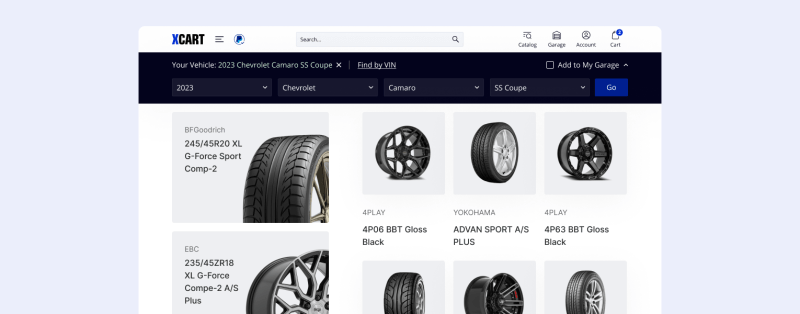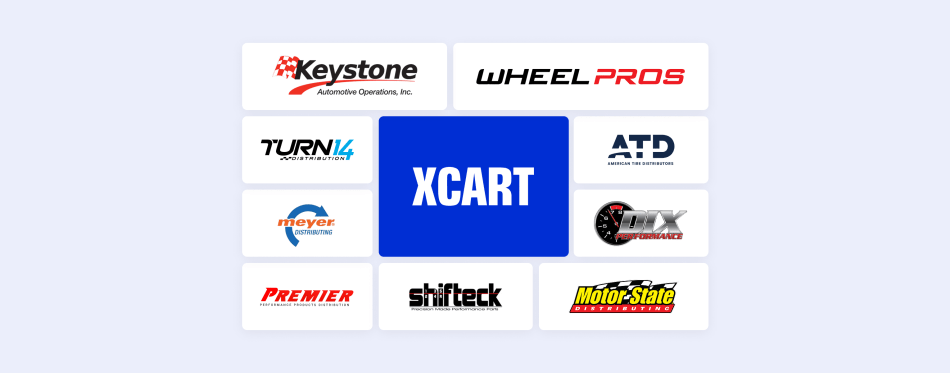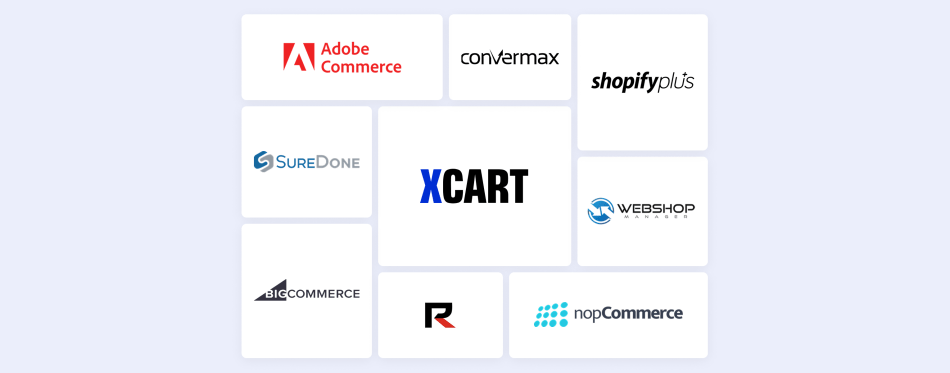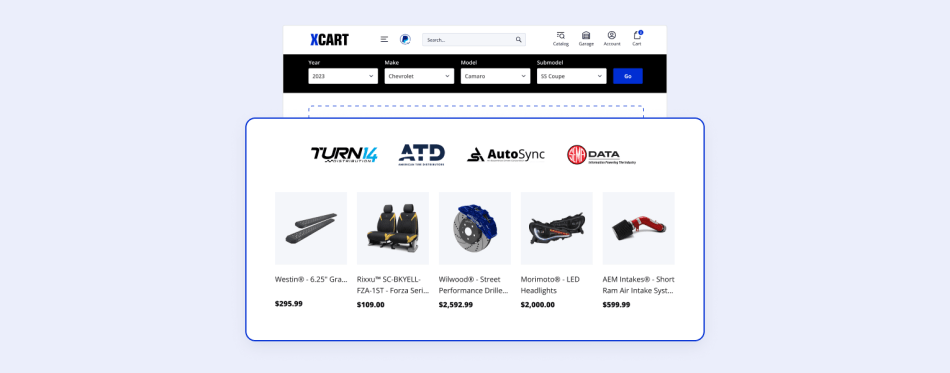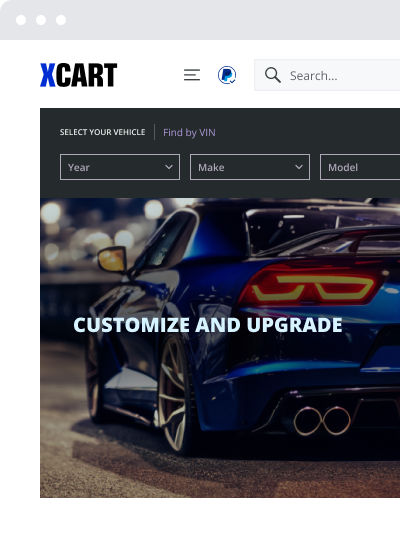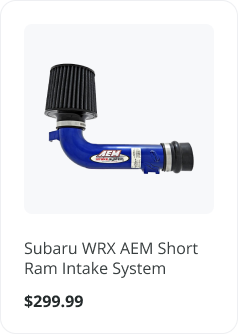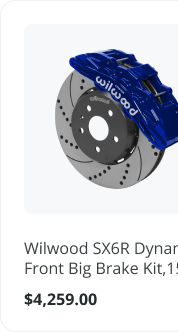Sell Wheels and Tires Online to Turn Them Into Wealth
Today, more and more auto parts businesses are tapping into digital commerce, and the automotive wheels market is no exception.
According to Aftermarket News, online sales of replacement tires in the United States have increased by 45% since 2020, while sales at physical stores have decreased by 11%. Additionally, the average price of a tire sold online has increased 54% over the past three years, while the price in brick-and-mortar stores has increased only 32%.
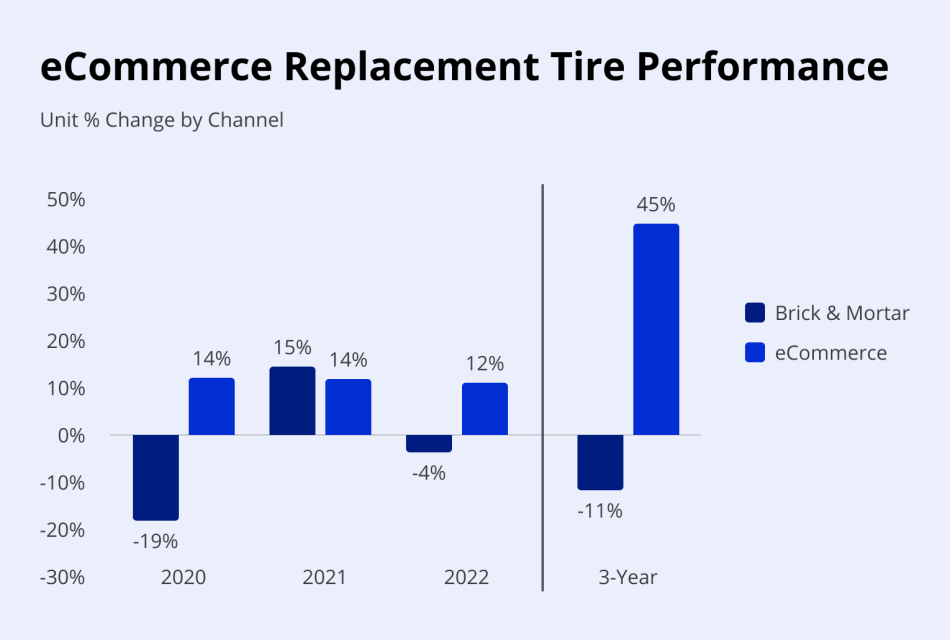
There is no better time to form an online presence for your wheels business and take advantage of the automotive eRetail market than now!
Selling auto parts online, however, requires a dynamic marketing strategy, robust technologies to fuel business growth, and a careful approach to avoiding potential pitfalls and imperfections.
Throughout this article, we will break down the best eCommerce tools, tips, and technologies for selling aftermarket wheels and factory OEM wheels online, highlight the primary challenges faced by online tire retailers, and provide solutions for keeping your eCommerce business operations in good condition.
Why Aftermarket and OEM Wheel Businesses Should Tap into eCommerce
The two most critical factors accelerating eCommerce adoption in the automotive aftermarket industry are shifting consumer behavior and growing competition among auto parts retailers.
These factors also ring true for the wheel and suspension niche, where eCommerce is quickly becoming a new normal.
Let’s take a closer look at each of the two factors mentioned above.
1. Evolving Consumer Expectations
For shoppers, purchasing online is a more beneficial alternative to in-store shopping due to the flexibility and ease of product search offered by auto parts eCommerce websites.
Did you know? According to SEMA, 83% of tire buyers start their shopping journey online by reading reviews and visiting several web shops. They do their tire research at their own pace and from the convenience of their homes.
Despite the recent fall in inflation, U.S. drivers still tend to stretch their car maintenance expenses, comparing prices online and seeking discounts. This is where we come closer to another reason for tire businesses to solidify their online brand awareness – competition.
2. Tough Competition Among Car Parts Retailers
In a highly competitive auto parts retail market, delivering a supreme online shopping experience is not an option, but a necessity, if you want to stay ahead of the pack.
For example, did you know that three out of four car parts shoppers look through five or more auto parts websites before buying online? In addition, 59 % of those shoppers will likely visit an online showroom only once (twice, at maximum!) and never return if it has a clunky digital interface or poor condition of navigation.
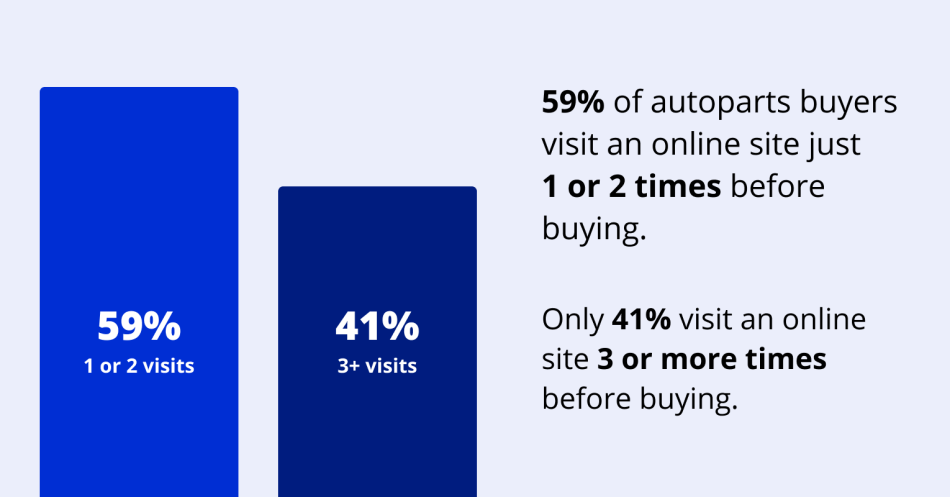
Having an eCommerce website is a must to get in front of consumers where they are looking and engage them in their initial buying journey before the transaction.
However, online brand visibility is not enough to convert shoppers. You’ll need to build (and constantly improve!) an appealing, high-performing online store that meets the expectations of tire buyers, aligns with your core business specifics, and answers automotive industry needs.
Choosing the Best eCommerce Platform for Your Wheels
An ideal automotive website relies on a shopping cart solution that provides all the necessary eCommerce features. However, the cookie-cutter approach to website building doesn’t work for the automotive niche.
For example, popular SaaS solutions with essential eCommerce features promise a facilitated launch and faster time-to-market. But if they don’t provide native automotive functionality or have poor customization options, you risk facing technology dead ends in the long run.
Unlike SaaS-based eCommerce platforms, API-driven solutions, like X-Cart or Adobe Commerce, offer much more flexibility for adding new functionality and tailoring your wheel & tire eCommerce solution to your vision.
Ultimately, you’ll need an automotive-centric eCommerce platform that will allow you to introduce customer-oriented ways of presenting data, adopt new technologies painlessly, automate and synchronize all the integrated systems (from payment gateways and inventory management systems to warehousing & fulfillment services and marketing automation tools), and manage them from a single place!
Top 5 Automation Challenges for Wheels Retail that an Automotive eCommerce Platform Resolves
1. Complex Catalog Management
Wheels and tires in your auto parts eCommerce catalog vary by vehicle type, width, RIM diameter, and load index, to name a few. They also advance in complexity and design year after year, sparking new challenges when it comes to updating your inventory and syncing it with the automotive databases.
Solutions:
- Limitless SKUs allow retailers to add new product page data and scale product catalogs painlessly.
- Catalog data integrations with reliable databases, such as AutoSync, ASAP, and SEMA allow to sync the inventory and ensure accuracy and compliance with the ACES/PIES standards.
- Robust import/export performance saves you time and effort by reducing the upload time while transferring your product data. This feature is crucial for automotive businesses with high-SKU catalogs.
- Bulk editing tools help sellers update the information for their entire stock simultaneously, synchronizing inventory management for various sales channels.
2. Unstable Website Performance
According to PR Newswire, about 50% of an automotive website’s conversion rate is influenced by website performance and page load time. While the average conversion rate of websites that load in eight seconds makes 1.0%, eCommerce shops that load in three seconds have a 1.8% average conversion rate.
Solutions:
- A dedicated web server backs your eCommerce website, allowing you to showcase all product page details, including high-quality images, without slowing down website performance and addressing the problem of decreasing page load time during traffic spikes.
Side note: X-Cart offers additional eCommerce hosting services for X-Cart-based shops, allowing you to get better website performance no matter where your customers are. Our service packages include web hosting, SEO consulting, migration, setup, and customer support.
3. Auto Parts Fitment Challenges
Providing accurate fitment data is the first thing you need for maintaining high profits. Incorrect orders can lead to missed sales, expensive returns, and a drop in customer loyalty.
To avoid this issue, you can utilize product fitments to gather precise information about specific car components and make it easier for customers to find the correct parts.
Solutions:
- Year Make Model (YMM) filters accurately capture all the features and specs of a specific vehicle to help customers quickly identify the auto parts for a particular car.
- VIN-based auto parts search allows customers to precisely determine the right parts for their car by using the vehicle identification number as the main search criterion.
- ‘My Garage’ feature lets customers include a particular vehicle category in their list and save this data for later product searches on your online store. By incorporating this feature, you offer customized experiences catered to individual shoppers, which can enhance each customer’s long-term value and encourage repeat purchases.
4. Messy or Incomplete Website Design
Showcasing your automotive brand through a compelling eCommerce website design and a well-built layout turns leads and traffic into solid sales. This is why not optimizing your online store’s look and feel is a huge miss. Sadly, most customers will just leave your website if it doesn’t have tire inventory with prices, simple auto parts search, or transparent navigation.
Solutions:
- Mobile-responsive automotive templates attract and capture customers’ attention, represent your business in line with your branding colors, and make a great first impression on any device your shoppers use.
- Faceted product search helps shoppers organize and filter large sets of product inventory to narrow their choices in real time with maximized accuracy.
- A custom storefront (Storefront API) powers unique user experiences and can be easily adjusted to the ever-changing automotive trends and shifts in consumer behavior, without impacting the backend side of the website.
- Product visualizer creates a more engaging customer experience and enables tire buyers to get an accurate visual representation. Its functionality lets one see each product from different angles, giving customers a comprehensive understanding of what they are buying. Visitors can zoom the image in to examine fine details closely, change the color of the vehicle, and find product specifications.
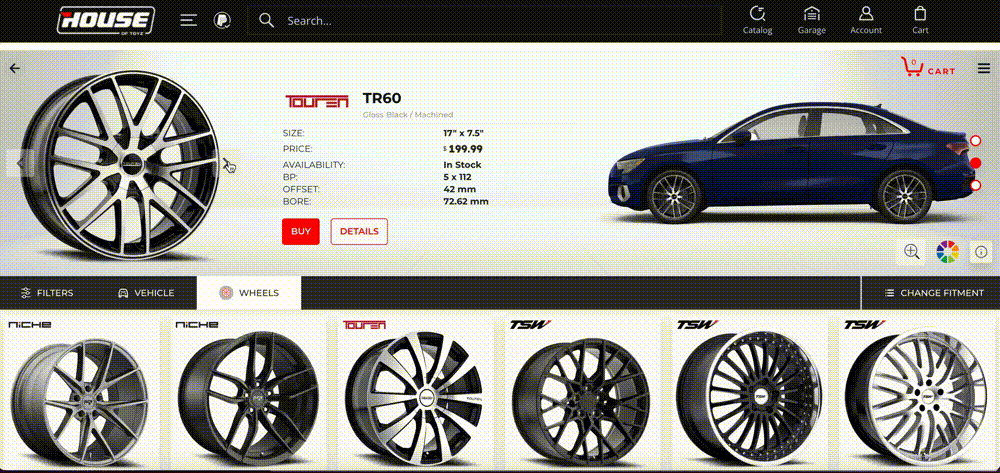
5. Order Fulfillment Synchronization and Automation
Order fulfillment refers to receiving and storing inventory, processing orders, shipping items to customers, and handling returns. And your main goal is to automate and sync all the systems involved to make them work smoothly at each step of your order fulfillment process.
Solutions:
- Dropship integrations simplify order management for an online retailer by connecting eCommerce software with the car parts suppliers to automatically transfer all order details directly to the manufacturer.
- Warehousing and distribution servicesconnect directly to your online store, allowing you to upload products in one click, ensure accurate pricing, and automate order processing, passing the burden of picking, packing, and shipping orders on to your reliable 3PL partner.
- Product bundling tools help automotive retailers streamline inventory management by automating how packages of products are bundled together and how orders are filled. A good example of such a bundle can be a set of tires or a wheel and tire package.
Can I Sell Aftermarket and Factory OEM Wheels on X-Cart?
Absolutely!
X-Cart is a flexible and scalable eCommerce platform tailored to selling wheels and tires. Thanks to our adjustable API-driven infrastructure and dedicated in-house development team, our solution combines built-in automotive features with industry-specific integrations.
What we offer:
- agile API-driven architecture
- mobile-responsive automotive design themes
- product visualization tool
- unlimited catalog scalability
- native integrations with automotive tools and services (SEMA Data, ASAP Network, AutoSync,, Turn 14 Distribution, and more)
- advanced search functionality
- Year/Make/Model filtering options, VIN lookup, and my ‘Garage feature’
- 24/7 technical support
- dedicated hosting
- in-house development team
X-Cart provides a perfect combination of accurate data, a customizable storefront, and synchronized internal operations to create an eCommerce website that caters to your automotive business requirements.
What wheels and tires online sellers LOVE about X-Cart Automotive:
- The power of eCommerce Automation. With a ready-made AutoSync integration, X-Cart sellers import wheels and tires catalog data and update it at a click!
- High-quality Product Visualization tool provided by AutoSync. Visualizer creates 3D models, not photos, of wheels and tires, which helps your customers see the products from different angles, even on trucks, and becomes a real wow factor.
- Product Category Mapping. Sellers value it for its immense help in structuring product categories. Category mapping allows you to import wheels and tires from your aftermarket data provider to the respective categories in your product catalog. This feature distinguishes X-Cart from other eCommerce platforms, e.g., Shopify.
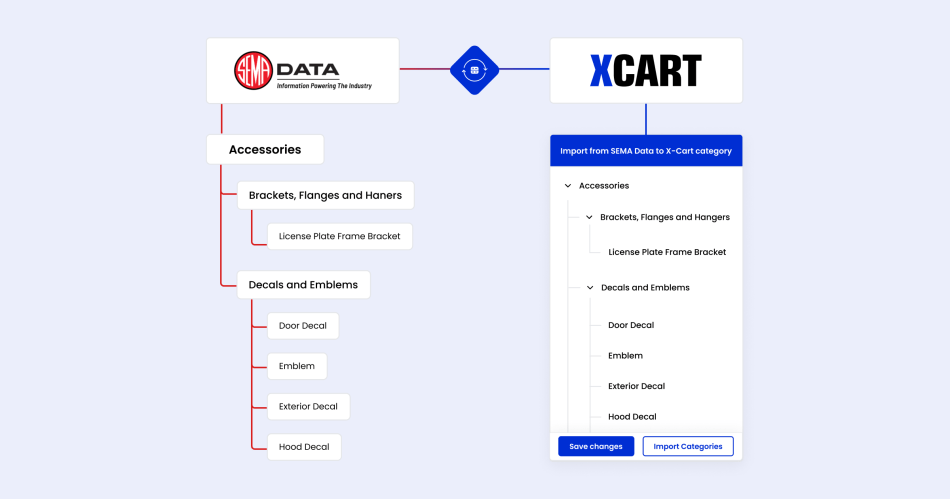
- Wheels and Tires design theme included in X-Cart Automotive package. This template is aimed at building a stunning online presence and showcasing your business in the automotive niche.
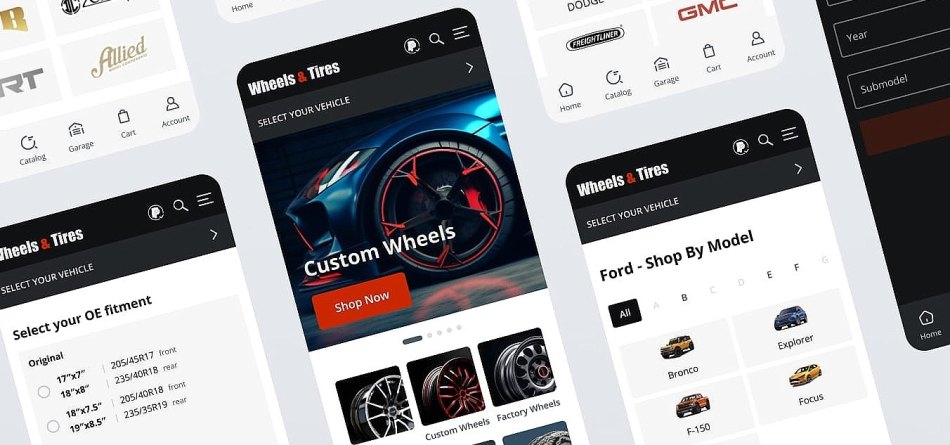
- Ability to import Vehicles and Fitment data. With the AutoSync integration, you can import vehicles and fitment data for the selected brands. It also enables fitment filters on your online store and eases customers’ search for particular tires and wheels.
The 5 Steps to Selling Wheels and Tires on X-Cart
👉 Step 1.
Install the latest version of X-Cart Automotive software on your server.
👉 Step 2.
Run through basic store configuration: set up your store profile by adding necessary information about your business. In this step, it’s important to define currency, measure units, and formats.
👉 Step 3.
Connect a wheels data provider. For instance, you can sign up for an account with AutoSync that works seamlessly with X-Cart via API.

AutoSync
Price: Free*, included in X-Cart Auto.
* to use this add-on, you must have a registered AutoSync account.
Though AutoSync has a ready-made integration with X-Cart, our customers always have an option to connect other wheels and tires applications as a custom project.
It is possible to customize an integration between X-Cart and American Tire Distributors (ATD), Keystone Automotive Operations, or another company.
👉 Step 4.
Import wheels and tires brands from AutoSync to X-Cart in a few clicks, and then import vehicle data as well. To keep your store up-to-date, there is a re-importing feature that allows you to add new brands or update the ones that you have. After you populate your store with products, it is up to you whether to manage the catalog manually or enable automated import scheduling.
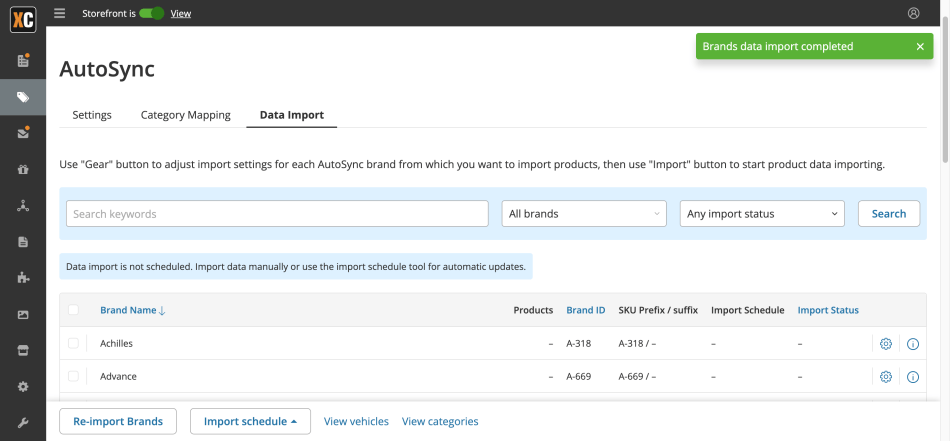
👉 Step 5.
Proceed to the final steps of store configuration, such as accepting payments, shipping methods, and taxes. If any questions arise, our exceptional customer support team is available 24/7 to help you on the phone, via email, or in chat.
Moreover, each X-Cart Automotive seller gets four one-hour onboarding calls with a dedicated customer success manager and a technical support engineer.
Together, we’ll discuss how to launch hassle-free and streamline your wheels and tires sales!
Ready to Open a Wheel Online Store with X-Cart?
Key Takeaway
In the rapidly growing automotive eCommerce sector, establishing an online presence for wheels, tires, and accessories businesses is essential. Besides effective automotive marketing strategies, eCommerce success demands robust software to avoid flaws.
By leveraging flexible eCommerce platforms like X-Cart and addressing key automotive businesses’ pain points (critical fitment accuracy, a large amount of product data, and a few more), wheels and tires online store owners can expect to thrive and succeed.
FAQs
I’m thinking about selling a wide range of products, including heavy-duty options like steel wheels, online. How important is it for my website to perform well?
About half of an automotive website’s conversion rate is impacted by how fast it loads. Websites loading in three seconds have a 1.8% average conversion rate, which is significantly better than the 1.0% for sites that take eight seconds.
So, yes, it’s incredibly important! A good platform like X-Cart helps by backing your site with dedicated web servers, ensuring your detailed product pages (even with high-quality pictures of the robust steel wheels) load quickly during busy periods.
How can an online store excel in user experience and ensure customers can easily find exactly what they’re looking for? Is there a kind of grading scale for how “user-friendly” an automotive eCommerce site should be?
There isn’t one official user-friendliness grading scale for automotive eCommerce, but three out of four car parts shoppers look at five or more websites before buying, and nearly 60% won’t return if a site is clunky or hard to navigate.
So, the “grade” for success really comes down to offering intuitive features: mobile-responsive designs that look great on any device, and especially advanced search functionalities like Year Make Model (YMM) filters or VIN-based search, which accurately help customers pinpoint the right parts for their specific vehicle.
About the author

